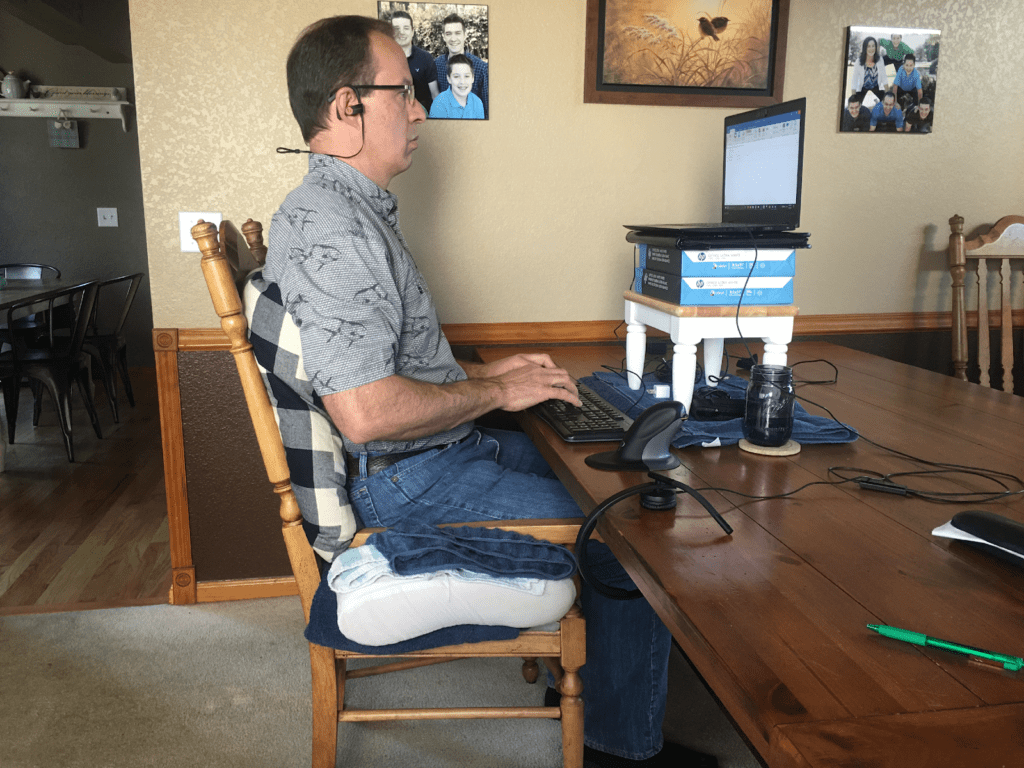Blog
Temporary Ergonomics for Employees Working from Home During Pandemic
This blog post can also be found on our Coronavirus Resource Center.
As many companies have been forced to adopt work-from-home policies amidst a pandemic, the typical recommendations for ergonomics are not so easy to achieve. Employers need to consider new recommendations for how employees can apply temporary ergonomic adjustments to their home offices.

Most of the time office ergonomic recommendations fit within a fairly narrow range of widely accepted, high quality, long-term solutions. These solutions consist of adjustable chairs, keyboard trays, monitor arms, sit to stand desks, and other equipment which can be purchased and kept in the office environment.
Permanent work-from-home programs and solutions vary widely from company to company but they are all similar to the office atmosphere in that the equipment is meant for a long period of time and purchases can be planned for and accomplished at a predictable pace.
Reacting to a much larger than normal number of employees working from home at a single point in time is a very different and difficult situation to respond to. Most companies cannot offer ergonomic equipment to all those working from home at the moment and even if they could, some types of equipment may not be available for quick delivery.
Even how an assessment should be done is different during this time of mass work-from-home numbers. It is not that ergonomic principles have changed, but employers’ ability to respond to the typical system-generated recommendations is extremely diminished. I have been asked to review two different evaluation systems in the past two weeks. Both were unchanged from the original office version and after filling them in, the system recommended a chair change and several other items not really applicable in this atmosphere.
So where does this leave employers in this atmosphere?
Top 6 Temporary Ergonomic Techniques
It goes against the grain of most safety and ergonomic professionals to recommend temporary or less-than-ideal solutions for ergonomic problems. This would include items such as using a towel and or pillows to build up chair pans or create a back support, elevating a laptop screen on a box or stool, or putting a book or box under unsupported feet. Some may even feel it is an issue of liability or professionalism. That said, this is a unique time and a temporary situation. I have sent the following to several clients and I consider it my simplified and temporary solution listing for the most crucial items during a temporary work-from-home situation.
My top 6 temporary ergonomic techniques include:
- Separate Keyboard and Mouse. Try to prevent working from a laptop without a separate keyboard and mouse. This is a starting point for the rest of the items below and will have to be combined with techniques 2and 3 in order to get the neck, shoulders, elbows, and wrists in the correct position.
- If possible, use a separate keyboard and mouse. If employees do not have these items and you can provide them, these should be the top two things on your list.
- Arrange the station so that elbows hang directly beneath your shoulders without shrugging, having them held or pushed away from your sides, or having to hold them forward.
- Try to get wrists in a neutral and comfortable position without having to flex or extend them.
- Elevate the Monitor. Elevate the monitor to be as close to eye level as possible.
- If you’re using a laptop but have a separate monitor, elevate that monitor to a height equal with your eyes, measured at the top line of print.
- If you are working from a laptop screen, use an external keyboard and mouse so that you can elevate your open laptop and place the monitor at a height equal with your eyes, measured at the top line of print.
- Adjust Chair and Table. If an adjustable task chair is not available and a non-adjustable chair must be used, utilize folded towels or pillows to raise the seat and support your upper and lower back. Hips and knees should be close to 90 degrees with feet firmly on the floor. If feet are not firmly supported by the floor, place a box or large book under them.
- Using adjustment of the chair pan height, keep elbows directly below shoulders, elbows at close to 90 degrees, and wrists in a neutral position.
- Does the chair support both the upper and lower back? If not, place a towel or towels, or possibly pillows upright behind both the upper and lower back to comfort.
- Avoid contacting sharp edges with arms, hands, or wrists. If the hands or wrists are pivoting on a sharp edge, the chair height likely needs to be adjusted upward.
- Prevent Glare. Remember to adjust blinds and curtains to prevent excess glare or even bright backlighting around your monitor.
- Take Breaks. Frequent breaks to stand up, walk around, and focus on objects further away than the computer screen are just as important at home as they are in the office, if not more so. Stand when you can during calls and ensure you are standing up and moving around at least one time per half hour.
- Use a Headset. Be sure to use a bluetooth or wired headset when on calls.

Here is an example of my home temporary ergonomic setup, making the dining room table a functional and comfortable workspace.
An At-Home Risk: Trip and Fall
Although not a typical ergonomic issue, trips and falls in home offices are an issue and should be addressed in any work-from-home situation. The chosen work area should be kept clear of clutter, cords (temporary power cords, etc.), and even items which normally do not cause a problem but are in the walking path. Clean and clear walkways to and from the workstation is the goal.
Employees and employers need to strike an attainable balance for the temporary situation we find ourselves in when under an emergency work-from-home policy. If you have questions or wish to get input on specific ergonomic or safety items, please feel free to contact your Woodruff Sawyer account team or me directly.
Author
Table of Contents













